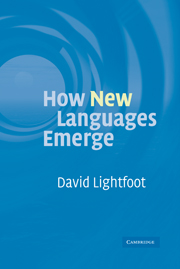Book contents
- Frontmatter
- Contents
- Preface
- 1 Internal languages and the outside world
- 2 Traditional language change
- 3 Some properties of language organs
- 4 Languages emerging in children
- 5 New E-language cuing new I-languages
- 6 The use and variation of grammars
- 7 The eruption of new grammars
- 8 A new historical linguistics
- References
- Index
7 - The eruption of new grammars
Published online by Cambridge University Press: 02 February 2010
- Frontmatter
- Contents
- Preface
- 1 Internal languages and the outside world
- 2 Traditional language change
- 3 Some properties of language organs
- 4 Languages emerging in children
- 5 New E-language cuing new I-languages
- 6 The use and variation of grammars
- 7 The eruption of new grammars
- 8 A new historical linguistics
- References
- Index
Summary
Creoles
Sometimes new grammatical properties emerge in rapid succession and well-defined, new languages erupt as if from the craters of Mount Vesuvius. This might happen in response to an especially heterogeneous triggering experience consisting of expressions from a variety of languages, including perhaps a pidgin.
Some owners of coffee, cotton, sugar, and tobacco plantations deliberately mixed slaves and workers from different language backgrounds. For example, when demand for Hawaiian sugar boomed just over a hundred years ago, workers were shipped in from China, Japan, Korea, the Philippines, Puerto Rico, and Portugal. Because of the nature of life on plantations and the practice of splitting up workers with a common language, no one of the languages could be fully acquired by everybody and serve as a lingua franca. When speakers of different languages, the substrate languages of the labor force, had to communicate in working contexts, they often developed makeshift jargons. These were pidgins and consisted of strings of words borrowed from the languages of the plantation owners, with little complexity and not much structure. The languages of the plantation owners, the European capital owners, and other socially dominant groups, were the superstrate languages.
Pidgins are created typically by adults with their own native tongues, using the evolving pidgin for limited purposes, specifically for interethnic communication; nobody uses a pidgin as a native language acquired under the normal conditions of childhood.
- Type
- Chapter
- Information
- How New Languages Emerge , pp. 139 - 160Publisher: Cambridge University PressPrint publication year: 2006

